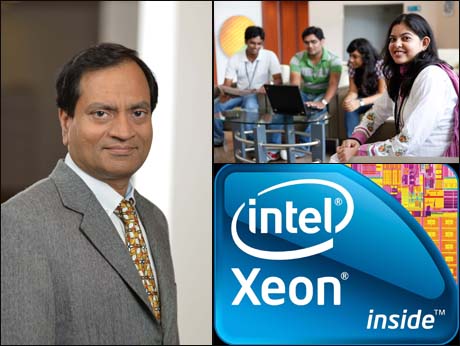
India may host a tiny fraction of the world's fastest computers, but her engineers are tops at building the bricks of a supercomputer. Ask Intel!
IndiaTechOnline Special Report. By Anand Parthasarathy
Bangalore, August 10 2015: Here's a high-tech irony! In spite of pumping thousands of crores of rupees into multiple government agencies in defence, atomic energy and civilian science for decades, India remains a scant presence in the list of the world's top 500 supercomputers: The latest list released last month, has just 11 India-based systems, representing just 2 percent of the total compute power. And only two of these can be said to be 'Made in India'.
Irony number 2: This country is the base where the number-crunching technology of almost every single supercomputer used anywhere in the world today is designed, honed and developed.
Why? Because Intel's Xeon family of chips is the most favoured processor for supercomputing:Intel-based system account for 86 percent of all supercomputers in the list of 500 systems: And is one of Intel's primary centres for Xeon design and development. In fact when I filtered out the India-based supercomputers in the July 2015 Top 500, 11 systems popped up and all of them had 'Intel Inside'.
" Every supercomputer in India has an Intel component, and the brains of hundreds of Intel High Performance Computing (HPC) engineers from India are making them tick", says Raj Hazra, Vice-President, Data Centre Group and General Manager, Technical Computing Group at Intel.
Pradeep Dubey, Intel Fellow and Director of Intel's Parallel Computing Lab , at Santa Clara, California (US) agrees: "Indians are uniquely qualified with the necessary analytical skills required, to address the challenges of high performance computing. I would go so far as to say, Intel's India-based research team holds a very key position when it comes to supercomputing skills like extreme-scale solvers, large-scale machine learning and inferencing algorithms."
Dr Dubey, a product of the Birla Institute of Technology, Mesra (Ranchi) -- and the University of Massachusetts at Amherst and Purdue University in the US -- is an Intel veteran of over 20 and the holder of over 30 patents, who was recently honored with Outstanding Electrical and Computer Engineer Award from Purdue University. I met him, when he came to Bengaluru, last month, soon after he took on a new responsibility of Fellow-in-Residence for Intel India. This means he visits regularly to mentor and guide Intel engineers in the India Development Centre and buckles their work into the global development efforts of Intel.
His lab always presents a record number of papers at peer events. At the last International Conference for HPC (SC '14, New Orleans), an Intel paper on the application of supercomputing structures for studying genome networks was a best paper nominee. Of the 8 co-authors, 6 were Indians; including the lead author, Sanchit Misra, 4 were based in India ( from IIT Mumbai and Intel India).
Another key paper and a finalist for the coveted Gordon Bell award, on peta-flop computing to simulate earthquakes was co-authored by Dr Dubey and another Indian -- Karthikeyan Vaidyanathan. Both Karthik and Sanchit are based in Intel India.
'Era of Tera'
The large number of Indians who contribute to cutting edge research in critical computing is nothing new. In 2007, Intel astonished the tech world by announcing that its engineers had ushered in the 'Era of Tera' with a tera flop processor with 80 cores on a single slab of silicon.( teraflop means 1 million compute operations in a second).
We are still at 4, 8 ... up to 18 cores today -- an 80-core practical chip is some years away. But 8 of the 12 engineers in the team who developed the futuristic prototype were Indians, half of them based in Bengaluru, led by a woman, Vasantha Erraguntla.
If so much of Indian talent in just one company, is focused on supercomputing skills, why is this huge talent not being dovetailed into India's own National Supercomputing Mission which earlier this year was given a 7 year target and a kitty of Rs 45 billion ( Rs 4500 crores)?
It is beginning to happen. Dr Dubey's mandate may soon touch a new initiative: an Intel India Maker Lab, in its Bengaluru campus to accelerate hardware design innovation by boosting product innovation and enhance maker capability for innovators and startups in India. Intel India would work closely with India’s startup ecosystem including Central/State Government incubation initiatives. “We are committed to the Government’s Digital India vision", says Intel India President, Kumud Srinivasan.
In a connected techno-commercial world it no longer matters who pays your monthly salary. And as Intel's Bengaluru-based engineers brainstorm with their mentor, Pradeep Dubey to take on new supercomputing challenges, to finalize their presentations for the upcoming SC conference in November, they are already India Makers, one and all. (additional reporting for this piece came from Vishnu Anand)